
Early Sunday morning, 11 May 2025 Dr. John Palumbo passed away at his home in Yuma, AZ. John was an excellent scientist and educator, a lifelong student who truly enjoyed good work and a full life. John was also a very good friend and colleague, not only to me but to the many with whom he worked and lived. We mourn his passing and miss him deeply.
I first met John in 1990 when he joined the faculty at the University of Arizona (UA) as an Assistant Professor and Extension Specialist in Entomology and Integrated Pest Management (IPM) based at the Yuma Agricultural Center (YAC). He came very highly recommended by Drs. Theo Watson and Leon Moore, who were research and Extension entomologists and former mentors of John’s when he was an undergraduate and graduate student at the UA.
John did his Ph.D. work at Oklahoma State University (OSU) under the direction of Dr. Larry Crowder, who had been on the UA faculty in entomology prior to moving to OSU. I am originally from Oklahoma and went to graduate school at OSU in agronomy and soil science. I used to jokingly tell John that having spent some formative years in Oklahoma was probably his time of refinement and saving grace.
John was a perfect fit for the position at the UA and at YAC; he was highly intelligent with an excellent background. Most importantly, it was very clear that he was enthusiastic about his opportunity, and he really wanted to do the work necessary. He truly loved his work, and he did it very well with passion and commitment.
John had an outstanding work ethic, he was a man of good character, and his integrity was exceptional. John was a practical realist, and even though we could both see and comment on the imperfections in the world around us, he did not whine or complain about things that could have been better. He was always an optimist, and he did the best with what he had, appreciated his opportunities, and he consistently did a great job with it. He was a model as a professional and as a good person. He had confidence in himself, but he was humble, and he always treated people with respect and dignity. Very importantly, John had a great sense of humor, and I could always count on that with him.
In 2018 John was diagnosed with stage 4 lung cancer. That was not a good prognosis, but John faced it with dignity and grace. John had access to some new drugs that helped give him a good quality of life that he sustained for seven years. In the past seven years he has been productive, worked hard, and he has had fun doing so. He did not dwell on the negative but always emphasized the positive.
John was an avid reader and we both shared an interest in history, particularly American history, including the Civil War. Many of our conversations centered around these common interests and we shared many good reading references.
In my readings I have also enjoyed the writings of Ernest Hemingway. Hemingway emphasized the value and benefits of living a robust life and spending time outdoors in nature. Many of his characters demonstrated a strong way of living and strength in facing the end of their lives. In one of Hemingway’s books (Across the River and Into the Trees) he offered a recounting of the passing of General Thomas “Stonewall” Jackson on 10 May 1863 following his injuries at the Battle of Chancellorsville.
Dr. McGuire, the attending physician, confirmed to Jackson what his wife had conveyed earlier regarding McGuire’s projection of his impending death that day. Jackson’s response after thinking for a moment was that the day was Sunday and he felt that Sunday was a good day to die. After passing in and out of delirium, the last he said was “Let us cross the river and rest in the shade of the trees.”
John Palumbo passed away on a Sunday in May. He has crossed the river and is now resting in the shade of the trees.
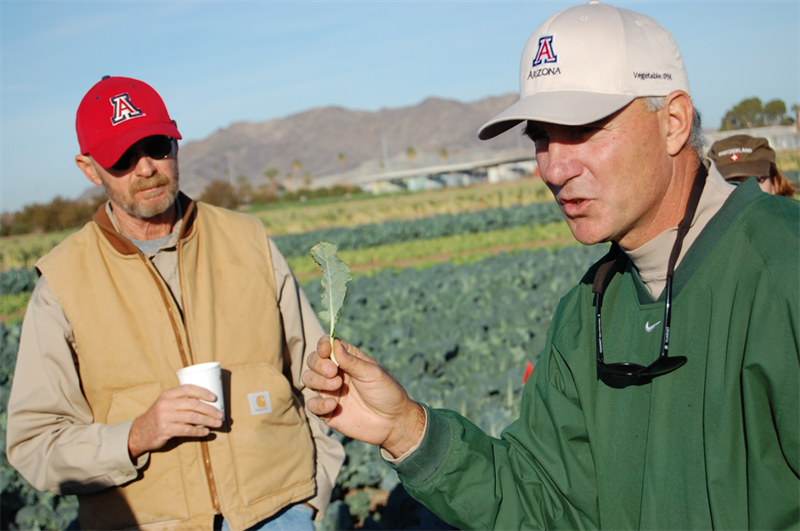
This study was conducted at the Yuma Valley Agricultural Center. The soil was a silty clay loam (7-56-37 sand-silt-clay, pH 7.2, O.M. 0.7%). Spinach ‘Meerkat’ was seeded, then sprinkler-irrigated to germinate seed Jan 13, 2025 on beds with 84 in. between bed centers and containing 30 lines of seed per bed. All irrigation water was supplied by sprinkler irrigation. Treatments were replicated four times in a randomized complete block design. Replicate plots consisted of 15 ft lengths of bed separated by 3 ft lengths of nontreated bed. Treatments were applied with a CO2 backpack sprayer that delivered 50 gal/acre at 40 psi to flat-fan nozzles.

Downy mildew (caused by Peronospora farinosa f. sp. spinaciae)was first observed in plots on Mar 5 and final reading was taken on March 6 and March 7, 2025. Spray date for each treatments are listed in excel file with the results.
Disease severity was recorded by determining the percentage of infected leaves present within three 1-ft2areas within each of the four replicate plots per treatment. The number of spinach leaves in a 1-ft2area of bed was approximately 144. The percentage were then changed to 1-10scale, with 1 being 10% infection and 10 being 100% infection.
The data (found in the accompanying Excel file) illustrate the degree of disease reduction obtained by applications of the various tested fungicides. Products that provided most effective control against the disease include Orondis ultra, Zampro, Stargus, Cevya, Eject .Please see table for other treatments with significant disease suppression/control. No phytotoxicity was observed in any of the treatments in this trial.
Founded in 2016, FarmWise has been at the forefront of AI based weeding technologies for nearly a decade. Over this time, the company has raised over $65 million in capital. In 2023, the company launched their flagship machine, Vulcan - a 21’ wide automated in-row smart cultivator for vegetable crops, priced at $645,000 (Fig. 1). In a surprising announcement just two weeks ago, FarmWise stated that the company was going through a business restructuring and will cease operations in the coming weeks. The bottom line for the decision was that despite having a field-tested automated weeding machine that reduces hand weeding labor costs, the company has not been able to reach profitability with the resources on hand. Moving forward, the company says that they are actively pursuing strategic opportunities including acquisition, partnerships and technology transfer to ensure the Vulcan technology lives on. During the transition, their number one priority is supporting current customers.
For insightful details on the need for restructuring and FarmWise’s plans going forward, you can refer to articles from The Packer and AgFunderNews.
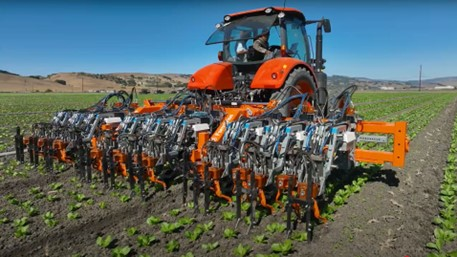
Fig. 1. FarmWise’s automated in-row smart cultivator, the Vulcan, operating in Salinas,
CA. (Photo credit: FarmWise, Santa Clara, CA)
Reference to a product or company is for specific information only and does not endorse or recommend that product or company to the exclusion of others that may be suitable
In our last update we invited you to come to the YAC to look at a broccoli trial we have in which we sprayed Trifluralin at 1.5 pt/ acre preemergence (PREE) incorporated mechanically. The application was made to the flat ground then incorporated with a disk at 4”depth. Then rows were built, and broccoli was direct seeded and germinated with sprinkler irrigation. Last year we saw injury in a non-disked Treflan treatment, so I didn’t include it in the trial. The same procedure was done with Prowl at 1pt with disked and non-disked plots.
Additional PREE treatments were Devrinol at 1pt/a, Prefar6qt/a, Goal tender at high rate of 16floz/a.
Prowl mechanically incorporated looks better than Non-incorporated in weed control as well as not showing phytotoxicity symptoms. Treflan, also mechanically incorporated looks similar to Prowl with a very small number of large weeds. The predominant weeds in this field are goosefoot and lambs quarter and are showing restricted growth not being as competitive with the broccoli.
Our observations in the trial as well as your field experience shows us with Treflan and Prowl available PREE and the post emergence herbicides such as Clethodim and Goal the absence of Cacthal can be mitigated to some degree. Again, you are welcome to come look at it at the Yuma Ag Center.
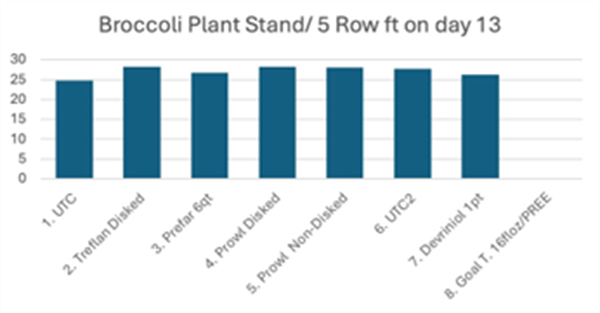
Treatments didn’t affect broccoli stand except Goal high rate PREE as expected.
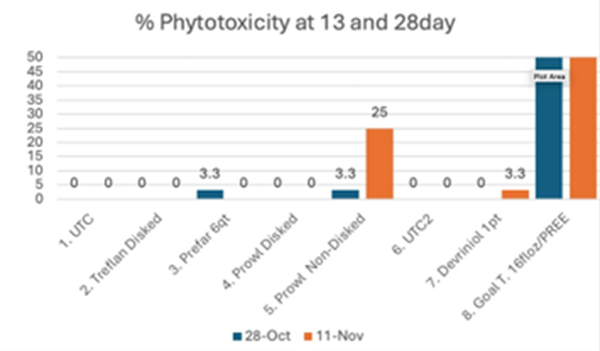
Prowl and Treflan applied on the flat and incorporated mechanically did not produced phytotoxicity symptoms at 13 and 28 days after planting.
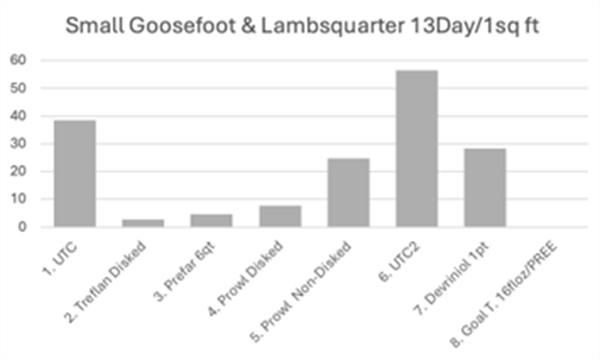
All weeds were about 0.5” at the time of this evaluation.
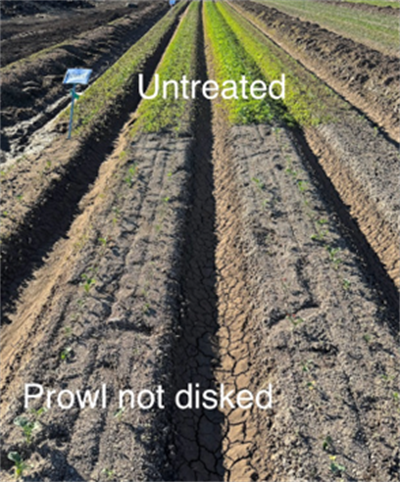
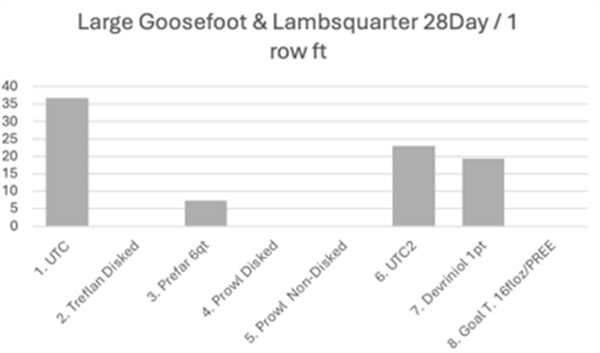
Some of the small weeds observed in the 13-day evaluation in the disked Prowl and Treflan died or didn’t grow by day 28.
Aphids are considered the most difficult to control insect pests in organic vegetables due to the lack of effective bioinsecticides as well as their ability to hide within plant structures. For instance, lettuce aphids normally hide in the head or heart of lettuce, making them difficult to reach by insecticide treatment or natural enemies. It is important to adopt other methods, such as nitrogen and water management, for additional aphid suppression.
As sap-sucking insects, aphids depend on the nutritional content of the sap ingested from the plant hosts for proper growth and development. Nitrogen availability is one of the most important factors in the development of aphid populations. Thus, limiting your nitrogen application to the optimum amount required for your crops is good practice for maintaining your aphid population below damaging level. Additionally, the use of slow-release (minimizing the risk of nutrient deficiency or excess) nitrogen fertilizer can be beneficial for aphid control. On the other hand, excess of nitrogen will make your crops a superfood for aphids. This accelerates the growth, development, and reproduction of the pests, reduces their generation time, and results in an increase in the number of generations and density during the cropping season. Excess of nitrogen particularly affects aphids on host crops such as lettuce, wheat, and sorghum. In some situations, high nitrogen levels in plant tissue can decrease resistance and increase susceptibility to aphids’ attacks. Applying the optimum amount of nitrogen fertilizer can tremendously help to manage aphids. In addition to pest management, effective fertilizer usage can also result in economic and environmental benefits.
Selected References:
1- Altieri, M. A., C. I. Nicholls, and M. A. Fritz. Manage insects on your farm: a guide to ecology strategies. SARE. https://www.sare.org/resources/manage-insects-on-your-farm/
2- Aqueel, M. A., and S. R. Leather. 2011. Effect of nitrogen fertilizer on the growth and survival of Rhopalosiphum padi (L.) and Sitobion avenae (F.) (Homoptera: Aphididae) on different wheat cultivars. Crop Protection. 30:216-221.
3- Bal, R., M. Groshok, and Y. Jama. 2024. Effects of nitrogen and potassium-based fertilizers on green peach aphid and abundance and arugula condition and growth. The Scientist. 6:1. https://journals.mcmaster.ca/iScientist/article/view/2931
4- Sinha, R., B. Singh, P. K. Rai, A. Kumar, S. Jamwal, and B. K. Sinha. 2018. Soil fertility management and its impact on mustard aphid, Lipaphis erysimi (Kaltenbach) (Hemiptera: Aphididae). Cogent Food & Agriculture. 4: 145094.
5- Xia, C., W. Xue, Z. Li, J. Shi, G. Yu, and Y. Zhang. 2023. Presenting the Secrets: exploring endogenous defense mechanisms in chrysanthemums against aphids. Horticulturae. 9: 937. https://doi.org/10.3390/horticulturae9080937
Supplying the optimum amount of water to your crop is also very important for effective pest control. Water availability around plant roots increases nitrogen absorption. Additionally, with high water availability, there is an increase in phloem pressure, making food more accessible to sap-sucking insect pests. Supplying the required amount of water using appropriate irrigation methods and irrigation scheduling can be beneficial for pest management. Although these practices will not completely prevent infestation of aphids, they can surely play a role in reducing the density of aphid populations on your crops.I had the privilege of knowing Dr. John Palumbo for nearly a year, and in that short time, he left a lasting impact on me both personally and professionally. From the moment I joined the Yuma Agricultural Center, John welcomed me with genuine generosity, readily offering his help and connecting me with key stakeholders in the Yuma area. Despite the demands of his extensive and impactful program, his office door was always open for any questions I had. Just a few weeks ago, I was attending a workshop in Imperial, California, hosted by the University of California Cooperative Extension. During the IPM session, I believe his name was mentioned more than ten times, underscoring the depth and influence of his research, findings, and recommendations. John was a true leader of the agricultural community in the Southwest, and his contributions will continue to shape the field for years to come. He leaves behind a legacy of excellence, mentorship, and service. Thank you, Dr. John Palumbo, for everything you have done. You will be deeply missed and fondly remembered.

Results of pheromone and sticky trap catches can be viewed here.
Corn earworm: CEW moth counts down in all traps over the last month; about average for December.
Beet armyworm: Moth trap counts decreased in all areas in the last 2 weeks but appear to remain active in some areas, and average for this time of the year.
Cabbage looper: Moths increased in the past 2 weeks, and average for this time of the season.
Diamondback moth: Adults increased in several locations last, particularly in the Yuma Valley most traps. Below average for December.
Whitefly: Adult movement remains low in all areas, consistent with previous years
Thrips: Thrips adult movement continues to decline, overall activity below average for December.
Aphids: Winged aphids still actively moving but declined movement in the last 2 weeks. About average for December.
Leafminers: Adult activity down in most locations, below average for this time of season.